

Listen to a Gophersnake
hissing defensively
|
 |
| Adult basking on a dirt road, Santa Cruz Island, Santa Barbara County © Russell Johnston |
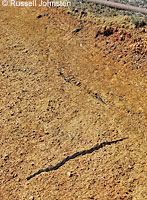 |
 |
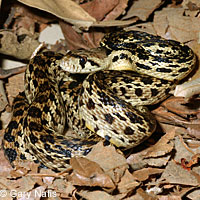 |
Adult basking on a dirt road, Santa Cruz Island, Santa Barbara County
© Russell Johnston |
Adult, Santa Barbara County. © Gary Nafis.
Specimen courtesy of Krista Fahy, Santa Barbara Museum of Natural History |
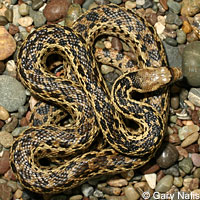 |
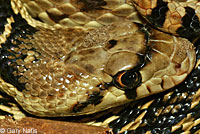 |
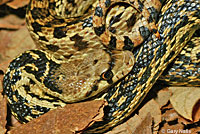 |
Adult, Santa Barbara County. © Gary Nafis. Specimen courtesy of Krista Fahy, Santa Barbara Museum of Natural History
|
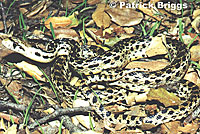 |
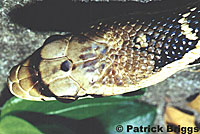 |
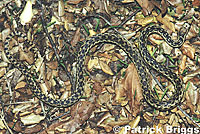 |
Adults, Santa Rosa Island, Santa Barbara County. Photos © Patrick H. Briggs,
Specimen courtesy of Santa Barbara Museum of Natural History
|
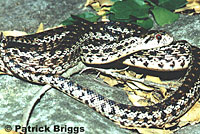 |
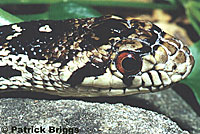 |
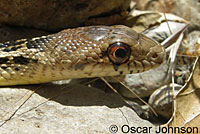 |
| Adult, Santa Cruz Island, Santa Barbara County. Photos © Patrick H. Briggs, Specimen courtesy of Santa Barbara Museum of Natural History |
Adult, Santa Cruz Island, Santa Barbara County © Oscar Johnson |
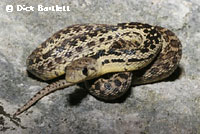 |
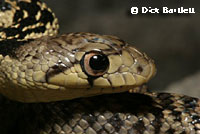 |
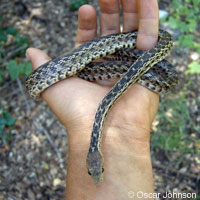 |
| Juvenile, Santa Cruz Island, Santa Barbara County © Dick Bartlett |
Adult, Santa Cruz Island, Santa Barbara County © Oscar Johnson |
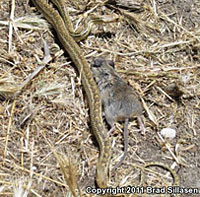 |
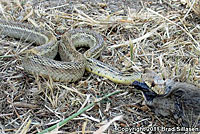 |
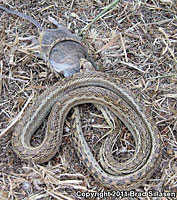 |
| An apparently pattern-aberrant sub-adult observed eating an already dead deer mouse on Santa Cruz Island, Santa Barbara County. © Laurie Van Stee |
| |
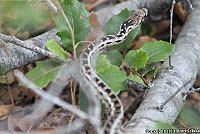 |
|
| |
Sub-adult, Santa Cruz Island, Santa Barbara County
© Laurie Van Stee |
|
| |
|
|
| Predators |
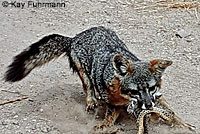 |
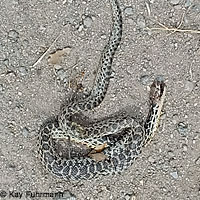 |
|
| This formerly-endangered Santa Cruz Island Fox was discovered preying on an adult Santa Cruz Island Gophersnake on Santa Cruz Island, Santa Barbara County. The fox dropped the snake when it saw that it was being watched but it returned later to carry the snake away. © Kay Fuhrmann |
|
|
|
|
| How to Tell the Difference Between Gophersnakes and Rattlesnakes |
 |
 |
 |
| |
 |
|
Harmless and beneficial gophersnakes are sometimes mistaken for dangerous rattlesnakes. Gophersnakes are often killed unnecessarily because of this confusion.
(It's also not necessary to kill every rattlesnake.)
It is easy to avoid this mistake by learning to tell the difference between the two families of snakes. The informational signs shown above can help to educate you about these differences. (Click to enlarge).
If you can't see enough detail on a snake to be sure it is not a rattlesnake or if you have any doubt that it is harmless, leave it alone.
You should never handle a snake unless you are absolutely sure that it is not dangerous.
|
| |
| Habitat |
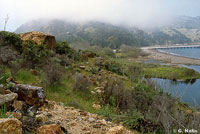 |
 |
 |
| Habitat - Santa Cruz Island, Santa Barbara County |
| |
| Short Videos of other Subspecies of Gophersnakes |
 |
 |
 |
| A San Diego Gophersnake flicks its tongue and crawls across a dirt road. |
A distressed Pacific Gophersnake shakes its tail rapidly, which makes a buzzing sound as the tail touches the ground. This behavior might be a mimic of a rattlesnake's rattling, or it could be a similar behavior that helps to warn off an animal that could be a threat to the gopher snake. |
A Sonoran Gophersnake crawls around in Imperial County. |
 |
 |
|
| A large Great Basin Gophersnake crawls off a road in a Mojave desert canyon. |
A huge Sonoran Gophersnake puts on an impressive defensive display of hissing and blowing. |
|
|
|
|
|
Description |
Not Dangerous - This snake does not have venom that can cause death or serious illness or injury in most humans.
Commonly described as "harmless" or "not poisonous" to indicate that its bite is not dangerous, but "not venomous" is more accurate. (A poisonous snake can hurt you if you eat it. A venomous snake can hurt you if it bites you.)
|
| Size |
Adults of the species Pituophis catenifer can be 2.5 - 9 feet long (76 - 279 cm). (Stebbins, 2003)
Hatchlings are fairly long, generally around 15 inches in length (38 cm), but hatchlings of this subspecies have been recorded at only 6.5 - 9 inches in length.
This subspecies, Pituophis catenifer pumilus, is a small or "dwarf" subspecies. Adults only grow to just over 3 feet long
(91 cm.)
|
| Appearance |
A large snake with heavily keeled scales, a narrow head that is slightly wider than the neck, and a protruding rostral scale on the tip of the snout that is slightly rounded.
|
| Color and Pattern |
Ground color is olive, grayish, or brownish with small discrete dark blotches along the back and smaller markings on the sides.
The underside is pale and lightly speckled.
The back of the neck is dark.
There is usually a dark stripe across the head in front of the eyes and a dark stripe from behind each eye to the angle of the jaw.
Juveniles tend to have a darker and more compact pattern than adults.
Key to California gophersnake subspecies.
|
| Life History and Behavior |
Activity |
Gophersnakes are generally active in the daytime, and at night in hot weather, and especially at dusk and dawn.
They are good burrowers, climbers, and swimmers. |
| Defense |
When threatened, a gophersnake will do several things, sometimes one after the other, including: crawling away quickly to escape or hide; freezing up - making the body rigid and kinked up so it won't be noticed or perceived as a snake; and striking at the threat to scare it off. Gophersnakes also use a more dramatic defensive behavior - sometimes a snake will elevate its body and inflate it with air while flattening its head into a triangular shape, hissing loudly, and quickly shaking its tail back and forth to make a buzzing sound.
(This head-flattening and tail-rattling is usually considered to be a mimic of a rattlesnake, but the tail shaking could be a behavior similar to that of the rattlesnake that helps to warn off an animal that could be a threat to the snake by alerting it of the snake's presence.)
Gophersnakes have a specially-developed epiglottis which increases the sound of their hiss when air is forced through the glottis. You can listen to a recording of a gophersnake hissing here, and watch short movies of a gophersnake hissing and striking here, and shaking its tail here. |
| Diet |
Due to the more limited fauna of the islands, Santa Cruz Island Gophersnakes have a less varied diet than other subspecies of gophersnakes. Their diet probably includes mice, lizards, birds eggs and nestlings. Juveniles probably take small lizards, mice, and possibly insects.
A powerful constrictor; kills prey by suffocating them in body coils or by pressing the animal against the walls of their underground burrows. |
| Reproduction |
Mating occurs in spring after emergence from winter hibernation.
Females are oviparous, laying one to 2 clutches of 2-24 eggs from June - August. (Stebbins, 2003)
Eggs hatch in 2 - 2.5 months.
|
| Habitat |
Occurs in all types of vegetation found on the islands. Most common in open grassland, dry streambeds, and oak and chaparral woodlands.
|
| Geographical Range |
This subspecies, Pituophis catenifer pumilus - Santa Cruz Island Gophersnake, occurs only on two (possibly three) of the Channel Islands south of the Santa Barbara coast - Santa Cruz and Santa Rosa Islands. There is also an unverified sight record from San Miguel Island.
The species Pituophis catenifer - Gophersnake, occurs from southern Canada in British Columbia, Alberta and Saskatchewan, south into Mexico, and east to Indiana and east Texas, excluding most of Arkansas, Minnesota, and North Dakota, and much of Illinois and Wisconsin. It is also found in the Channel Islands and on islands off the west coast of Baja California.
|
 |
| Elevational Range |
Gophersnakes range from below sea level to around 9,186 ft. (2,800 m). (Stebbins, 2003)
This subspecies ranges from near sea level to 2,100 feet (640 m) on Santa Cruz Island.
|
| Notes on Taxonomy |
8 subspecies of Gophersnake - Pituophis catenifer - are recognized. Two occur in Baja California, and six occur in the United States. It has been proposed that the snakes from Baja California are a new species. Five of these eight subspecies occur in California, with one endemic, and one that only occurs in California and Baja California.
---------------------------------------------------------------------------------------------------------------------------------------------------------------------
The species name was originally spelled "pumilus" by Klauber in 1946 but it was changed to "pumilis" sometime shortly after that (possibly by mistake) and "pumilis" was used by many, including this site.
---------------------------------------------------------------------------------------------------------------------------------------------------------------------
Gophersnakes are related to Ratsnakes and Kingsnakes, and they have been known to interbreed with these species.
---------------------------------------------------------------------------------------------------------------------------------------------------------------------
"The English name for the genus is simplified to “Bullsnakes” because it is descriptive for all of the species."
(Nicholson, K. E. (ed.). 2025 SSAR Scientific and Standard English Names List)
---------------------------------------------------------------------------------------------------------------------------------------------------------------------
Alternate and Previous Names (Synonyms)
Pituophis catenifer pumilus - Santa Cruz Island Gopher Snake (Stebbins 2003, Stebbins & McGinnis 2012)
Pituophis melanoleucus pumilus - Santa Cruz Gopher Snake (CA Dept. of Fish and Game)
Pituophis melanoleucus pumilis - Santa Cruz Island Gopher Snake (Stebbins 1985)
Pituophis melanoleucus pumilis - Santa Cruz Island Gopher Snake (Stebbins 1966)
Pituophis catenifer pumilis (Stebbins 1954)
Pituophis catenifer catenifer - Western Gopher Snake (Pituophis annectens; Pityophis Heermanni; Pityophis vertebralis; Pityophis sayi bellona, part; Pityophis sayi; Pituophis bellona, part; Pituophis melanoleucus; Pituophis melanoleucus var. catenifer. Pacific Bull Snake; Bellona Bull Snake; Western Bull Snake, part; Pacific Pine Snake; Gopher Snake, part; Say's Pine Snake; Yellow Gopher Snake) (Grinnell and Camp 1917)
Channel Island Gopher Snake
Santa Cruz Gopher Snake
|
| Conservation Issues (Conservation Status) |
| The proliferation of feral livestock such as sheep and pigs may have had an impact on populations of this snake by altering the vegetation and landscape. Pigs have also been known to eat snakes. Attempts have been made to remove or eradicate these introduced species. |
|
| Taxonomy |
| Family |
Colubridae |
Colubrids |
Oppel, 1811 |
| Genus |
Pituophis |
Bullsnakes, Gophersnakes, and Pinesnakes |
Holbrook, 1842 |
| Species |
catenifer |
Gophersnake |
(Blainville, 1835) |
Subspecies
|
pumilus |
Santa Cruz Island Gophersnake |
Klauber, 1946 |
|
Original Description |
Pituophis catenifer - (Blainville, 1835) - Nouv. Ann. Mus. Hist. Nat. Paris, Vol. 4, p. 290, pl. 26, figs. 2-2b
Pituophis catenifer pumilus - Klauber, 1946 - Trans. San Diego Soc. Nat. Hist., Vol. 11, p. 41, pl. 3
from Original Description Citations for the Reptiles and Amphibians of North America © Ellin Beltz
|
|
Meaning of the Scientific Name |
Pituophis - Greek - pitys = pine + ophis = snake - possibly referring to the habitat of the nominate subspecies on U.S. east coast (the Pine Snake)
catenifer - Latin - catena = chain + -ifera = bearing - referring to the chain-like dorsal pattern
pumilus - Latin = diminuitive or dwarfish
from Scientific and Common Names of the Reptiles and Amphibians of North America - Explained © Ellin Beltz
|
|
Related or Similar California Snakes |
P. c. affinis - Sonoran Gophersnake
P. c. annectens - San Diego Gophersnake
P. c. catenifer - Pacific Gophersnake
P. c. deserticola - Great Basin Gophersnake
|
|
More Information and References |
California Department of Fish and Wildlife
Patrick Briggs' World Pituophis Site
The Pituophis Page: P. c. pumilis
Hansen, Robert W. and Shedd, Jackson D. California Amphibians and Reptiles. (Princeton Field Guides.) Princeton University Press, 2025.
Stebbins, Robert C., and McGinnis, Samuel M. Field Guide to Amphibians and Reptiles of California: Revised Edition (California Natural History Guides) University of California Press, 2012.
Stebbins, Robert C. California Amphibians and Reptiles. The University of California Press, 1972.
Flaxington, William C. Amphibians and Reptiles of California: Field Observations, Distribution, and Natural History. Fieldnotes Press, Anaheim, California, 2021.
Nicholson, K. E. (ed.). 2025. Scientific and Standard English Names of Amphibians and Reptiles of North America North of Mexico, with Comments Regarding Confidence in Our Understanding. Ninth Edition. Society for the Study of Amphibians and Reptiles. [SSAR] 87pp.
Samuel M. McGinnis and Robert C. Stebbins. Peterson Field Guide to Western Reptiles & Amphibians. 4th Edition. Houghton Mifflin Harcourt Publishing Company, 2018.
Stebbins, Robert C. A Field Guide to Western Reptiles and Amphibians. 3rd Edition. Houghton Mifflin Company, 2003.
Behler, John L., and F. Wayne King. The Audubon Society Field Guide to North American Reptiles and Amphibians. Alfred A. Knopf, 1992.
Robert Powell, Roger Conant, and Joseph T. Collins. Peterson Field Guide to Reptiles and Amphibians of Eastern and Central North America. Fourth Edition. Houghton Mifflin Harcourt, 2016.
Powell, Robert., Joseph T. Collins, and Errol D. Hooper Jr. A Key to Amphibians and Reptiles of the Continental United States and Canada. The University Press of Kansas, 1998.
Bartlett, R. D. & Patricia P. Bartlett. Guide and Reference to the Snakes of Western North America (North of Mexico) and Hawaii. University Press of Florida, 2009.
Bartlett, R. D. & Alan Tennant. Snakes of North America - Western Region. Gulf Publishing Co., 2000.
Brown, Philip R. A Field Guide to Snakes of California. Gulf Publishing Co., 1997.
Ernst, Carl H., Evelyn M. Ernst, & Robert M. Corker. Snakes of the United States and Canada. Smithsonian Institution Press, 2003.
Taylor, Emily. California Snakes and How to Find Them. Heyday, Berkeley, California. 2024.
Wright, Albert Hazen & Anna Allen Wright. Handbook of Snakes of the United States and Canada. Cornell University Press, 1957.
Schoenherr, Allan A. Natural History of the Islands of California. The University of California Press, 2003.
Joseph Grinnell and Charles Lewis Camp. A Distributional List of the Amphibians and Reptiles of California. University of California Publications in Zoology Vol. 17, No. 10, pp. 127-208. July 11, 1917.
|
|
|
The following conservation status listings for this animal are taken from the April 2024 State of California Special Animals List and the April 2024 Federally Listed Endangered and Threatened Animals of California list (unless indicated otherwise below.) Both lists are produced by multiple agencies every year, and sometimes more than once per year, so the conservation status listing information found below might not be from the most recent lists. To make sure you are seeing the most recent listings, go to this California Department of Fish and Wildlife web page where you can search for and download both lists:
https://www.wildlife.ca.gov/Data/CNDDB/Plants-and-Animals.
A detailed explanation of the meaning of the status listing symbols can be found at the beginning of the two lists. For quick reference, I have included them on my Special Status Information page.
If no status is listed here, the animal is not included on either list. This most likely indicates that there are no serious conservation concerns for the animal. To find out more about an animal's status you can also go to the NatureServe and IUCN websites to check their rankings.
Check the current California Department of Fish and Wildlife sport fishing regulations to find out if this animal can be legally pursued and handled or collected with possession of a current fishing license. You can also look at the summary of the sport fishing regulations as they apply only to reptiles and amphibians that has been made for this website.
|
| Organization |
Status Listing |
Notes |
| NatureServe Global Ranking |
G5T1T2 |
The species is: Apparently Secure.
This subspecies is: Critically Imperiled - Imperiled |
| NatureServe State Ranking |
S1? |
Critically imperiled?
|
| U.S. Endangered Species Act (ESA) |
None |
|
| California Endangered Species Act (CESA) |
None |
|
| California Department of Fish and Wildlife |
WL |
Watch List |
| Bureau of Land Management |
None |
|
| USDA Forest Service |
None |
|
| IUCN |
None |
|
|
|






































